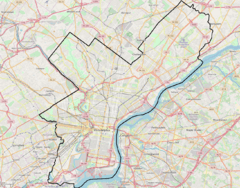Mount Airy, Philadelphia facts for kids
Quick facts for kids
Mount Airy
|
|
|---|---|
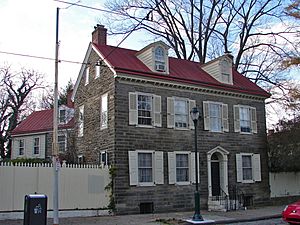
Daniel Billmeyer House on Germantown Avenue
|
|
| Country | United States |
| State | Pennsylvania |
| County | Philadelphia County |
| City | Philadelphia |
| ZIP Code |
19119
|
| Area code(s) | 215, 267, and 445 |
Mount Airy is a cool neighborhood located in Northwest Philadelphia, Pennsylvania. It's known for its beautiful homes, green spaces, and friendly community. Many people love living here because it feels like a small town, but it's still part of a big city.
Contents
Exploring Mount Airy's Location
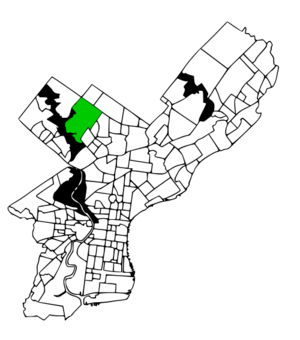
Mount Airy has natural borders that make it special. To the northwest, you'll find the Cresheim Valley, which is part of Fairmount Park. Beyond this valley is the neighborhood of Chestnut Hill.
On the west side, there's the Wissahickon Gorge, also part of Fairmount Park. Across the gorge are the neighborhoods of Roxborough and Manayunk.
Mount Airy's Neighbors and Borders
Germantown borders Mount Airy to the southeast. Stenton Avenue marks the northeast edge. Beyond Stenton Avenue, you'll find Cedarbrook and West Oak Lane. Some people even consider Cedarbrook to be part of Mount Airy.
The USPS uses the 19119 ZIP Code for Mount Airy. This ZIP code covers almost all of the area that people think of as Mount Airy.
Mount Airy and Germantown: A Close Connection
There isn't a clear line between Mount Airy and Germantown. Most people agree that Johnson Street is the unofficial border. However, some local groups think Washington Lane is the southern edge of Mount Airy. The two neighborhoods blend together very smoothly.
Historically, this entire area was part of the German Township. Many buildings in Mount Airy still have "Germantown" in their names, like the Germantown Jewish Centre. This shows how closely linked the two areas have always been. Even parts of the Battle of Germantown in 1777 happened right here in Mount Airy!
The History of Mount Airy
Mount Airy got its name from a large estate built in 1750. William Allen, a rich merchant and judge, built his summer home on Germantown Avenue. He called his mansion "Mount Airy," and soon the whole area took that name.
Before it was called Mount Airy, this area was part of two older sections of Germantown Township: Cresheim and Beggarstown.
The Village of Cresheim
The village of Krisheim (or Cresheim) started with the original land divisions of Germantown Township in 1689. This area was given to some of the first settlers of Germantown. It stretched from Stenton to Wissahickon Avenues. The name "Cresheim" comes from a town in Germany called Kriegsheim, where some early German Quaker families came from. By the early 1800s, the name Mount Airy began to replace Cresheim.
The Story of Beggarstown
Beggarstown was another early area, located along Germantown Avenue. It got its name because its first resident supposedly begged for money to build his house. This house later became a church. By the late 1800s, the name Beggarstown faded away, and the area was sometimes called Pelham, Germantown, or Mount Airy.
Mount Airy's Growth and Architecture
Most of modern Mount Airy grew in the late 1800s and early 1900s. It spread out from Germantown Avenue and the two railroad lines. You can see many large, beautiful homes here. These houses are often made of gray stone and have Victorian, Colonial Revival, or Norman and Cotswold styles. They often feature stained glass windows and slate roofs. These grand homes are found in areas like West Mount Airy's Pelham section and East Mount Airy's Gowen Avenue.
Mount Airy's Community and People
Mount Airy is home to many different people. In 2021, about 29,206 people lived here. About 57.4% of residents were Black or African-American, and 33.2% were White. The neighborhood has about 12,564 households. The average household size is 2.3 people.
About 19.5% of Mount Airy's residents are under 18, and 19% are 65 or older. The average age is 42 years. More than half of the residents (54.4%) are female. The median household income was about $72,685.
A Model of Integration
Mount Airy is famous for being one of the first successfully integrated neighborhoods in America. This means people of different races live together and get along well. Residents worked hard to prevent unfair housing practices in the 1950s and 1970s.
The neighborhood continues to be a great example of racial diversity. O magazine and U.S. News & World Report have recognized Mount Airy for its racial harmony.
Education in Mount Airy
Mount Airy has many schools for kids of all ages.
Schools for Younger Students
The School District of Philadelphia runs the public schools. Some elementary schools (K–5) in Mount Airy include Eleanor C. Emlen School. K–8 schools (kindergarten through 8th grade) include Charles W. Henry School, Henry H. Houston School, and Anna L. Lingelbach School. After these schools, students usually go to Roxborough High School.
There are also charter schools like West Oak Lane Charter School and Wissahickon Charter School.
Private Schools in the Area
Mount Airy has several private schools:
- Blair Christian Academy (PreK–12)
- Revival Hill Christian High School (9–12)
- Islamic Day School of Philadelphia (PreK–5)
- Waldorf School of Philadelphia (PreK–8)
- Project Learn School (K–8)
- Classroom on Carpenter Lane (K–2)
- Holy Cross School (K–8)
Nearby Germantown also has private schools like Germantown Friends School (K–12) and William Penn Charter School (K–12).
Colleges and Universities Near Mount Airy
If you're thinking about college, there are several universities close by:
- Arcadia University
- Chestnut Hill College
- La Salle University
- Thomas Jefferson University
- Saint Joseph's University
Public Libraries
The Free Library of Philadelphia has the Lovett Square Branch right in Mount Airy, at 6945 Germantown Avenue. It's a great place to find books and learn!
Getting Around Mount Airy
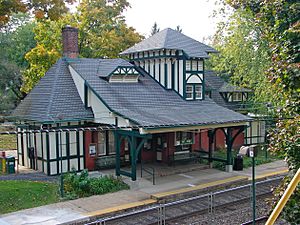
It's easy to get around Mount Airy and to Center City using public transportation.
Train Lines
Two SEPTA Regional Rail lines serve the neighborhood:
- The Chestnut Hill West Line runs through West Mount Airy. It has stops at Upsal, Carpenter, and Allen Lane stations.
- The Chestnut Hill East Line goes through East Mount Airy. Its stops include Mount Airy, Sedgwick, and Stenton stations.
Bus Routes
Mount Airy is also served by several bus routes, including 18, 23, 53, H, and L.
Mount Airy's Culture and Community Life
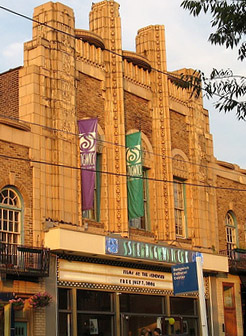
In recent years, Mount Airy has seen a "cultural revival." The New York Times noted new businesses coming to the area. In 2013, CNNMoney even called Mount Airy one of America's top ten best big-city neighborhoods!
The community is generally very open-minded and progressive.
Places of Worship
Mount Airy has several places of worship:
- Three Jewish congregations: Germantown Jewish Centre, P'nai Or Jewish Renewal Congregation of Philadelphia, and Chabad-Lubovitch of Northwest Philadelphia.
- A Hare Krishna community on West Allens Lane.
Shopping and Fun on Germantown Avenue
Mount Airy's main shopping area is along stone-paved Germantown Avenue. This street also divides East and West Mount Airy. Here, you'll find:
- Unique independent shops
- Restaurants
- Art galleries
- Clothing stores
- Coffee shops
- A gastropub (a pub that serves high-quality food)
- Wine bars
- Fitness centers
- Professional offices
Mount Airy also has two covered farmers' markets where you can buy fresh, local food. The Sedgwick Theater, a beautiful 1920s Art Deco movie theater, is now home to the Quintessence Theatre Group, which puts on plays.
Weavers Way Co-op
The Weavers Way Co-op is a long-running grocery store in West Mount Airy. It's a "co-op," meaning it's owned by its members. Weavers Way also runs two farms, works with local schools, and provides fresh food to a shelter.
Famous People from Mount Airy
Many interesting and talented people have lived in Mount Airy! Here are just a few:
- Sadie Tanner Mossell Alexander: The first African American woman to get a Ph.D. from the University of Pennsylvania.
- Sandra Boynton: A popular cartoonist and author of children's books.
- Dan Bricklin: An inventor and entrepreneur.
- Linda Creed: A lyricist who co-wrote many famous "Philly Sound" songs.
- Charles Darrow: The person who developed the board game Monopoly.
- A. Leon Higginbotham Jr.: The first African American judge on a major federal court in Pennsylvania.
- Connie Mack: A famous baseball manager and owner.
- Violet Oakley: A well-known artist.
- Holly Robinson Peete: An entertainer.
- Saul Perlmutter: A Nobel Prize-winning astrophysicist.
- Bob Saget: A famous actor and TV host.
- Santigold: A hip-hop musician.
- Howard Martin Temin: A Nobel Prize-winning geneticist.
- Paul F. Tompkins: A comedian and TV host.
- C. Delores Tucker: A civil rights activist and the first black female Secretary of State in a U.S. state.
- Robert Venturi: A famous architect.
- Kurt Vile: An indie rock musician.
- Grover Washington Jr.: A jazz musician.
Important Places in Mount Airy
Mount Airy has several important buildings and institutions:
- The Lutheran Theological Seminary at Philadelphia (LTSP) is a seminary (a school for religious studies) located at Germantown Avenue and Allens Lane.
- The Sedgwick Theater, built in the 1920s, is a beautiful Art Deco movie theater. It's one of the few left in Philadelphia.
- Many properties in Mount Airy are listed on the National Register of Historic Places. This means they are important historical sites. Some of these include:
- The Violet Oakley Studio
- The Nugent Home for Baptists
- The Mt. Airy Station
- Malvern Hall
- Cliveden
- Upsala
- Grace Church, Mt. Airy
- Henry H. Houston School
- Daniel Billmeyer House


